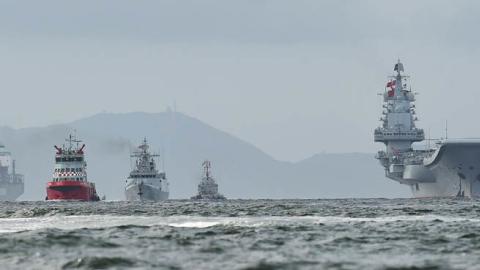The jury is still out about its efficacy, but U.S. President Joe Biden has offered a firm response to Russia’s invasion of Ukraine. The sanctions meant to punish Russian President Vladimir Putin and his inner circle have a chance of success, mainly because the United States’ European allies are standing by.
But would the United States be able to rely on its allies in the Indo-Pacific if some day, Chinese President Xi Jinping acts as aggressively as Putin?
Xi and Putin are markedly different, as are China’s and Russia’s external relationships. But authoritarian regimes can behave badly unexpectedly, and Washington must be prepared for China flexing its muscles over Taiwan or the South China Sea. Judging by the Biden administration’s recently announced Indo-Pacific strategy, the United States still lacks a serious plan to deter an increasingly assertive China.
U.S. strategy for containing the Soviet Union in Europe after World War II was anchored in NATO’s military power. But today’s Indo-Pacific strategy is anchored in hopes and intentions and lacks an identifiable hard-power component.
The document speaks of “modernized alliances; flexible partnerships, including an empowered ASEAN [Association of Southeast Asian Nations], a leading India, a strong and reliable [Quadrilateral Security Dialogue], and an engaged Europe; economic partnership; new U.S. defense, diplomatic, development, and foreign-assistance resources; sustained focus on and commitment to the region at all levels of the U.S. government.”
But it lacks specifics and does not take into account the greater interdependence between China and the economies of ASEAN and the so-called Quad countries. Given that interdependence, U.S. partners in Asia are less likely to fully support the kinds of sanctions that have been imposed on Russia.
The Biden administration’s Indo-Pacific strategy is, in many ways, a synthesis of policies adopted over the last two decades by successive U.S. administrations. Even when former U.S. presidents, such as Donald Trump, have spoken of the need to deter China from taking unfair advantage of the United States in trade, threatening Taiwan, and asserting its territorial claims in the South China Sea, they have consistently failed to specify how they would translate their intents into action. Trump launched a trade war with China, which also hurt U.S. businesses, but offered no plan to counter China’s military buildup.
China, under its Communist Party, has demonstrated the will to play the long game. For years, that game involved claiming that China sought to rise peacefully. There was no dearth of Americans who believed China. Even as he spoke of the United States’ pivot to Asia, former U.S. President Barack Obama envisioned a G-2, with China and the United States managing the world in partnership.
Historian Niall Ferguson spoke of Chimerica, an imagined U.S.-Chinese conjoined economy accounting for 13 percent of the world’s land area, a quarter of its population, and about a third of its GDP. And there was no shortage of voices favoring a Sino-American global order. In Asia, and the United States, it was not unusual to dismiss concerns about a rising threat from China.
There is widespread realization now that China is the United States’ peer competitor, not a partner, and Xi could create a showdown just as Putin has over Ukraine. But China is deeply insinuated into the U.S. economy and those of America’s potential partners in the Indo-Pacific.
Unlike the Europeans, who have stood by the United States against Russia, Washington’s Asian partners are not as united around dealing with China. And so far, the Biden administration has not publicly outlined how it intends to get U.S. allies and partners—Australia, Japan, South Korea, India, and the ASEAN countries (Brunei, Cambodia, Indonesia, Laos, Malaysia, Myanmar, the Philippines, Singapore, Thailand, and Vietnam)—to stand up to China, given that all of them benefit from being China’s economic partners.
The administration’s approach has been focused primarily on optics. For example, the 2022 Indo-Pacific Strategy was released when U.S. Secretary of State Antony Blinken was in the region. Biden is also scheduled to travel to several destinations in Asia this spring.
These visits are meant to convey the message that no region is more vital to the United States in the coming years and that U.S. security and prosperity are fundamentally dependent on and tied to those of the Indo-Pacific.
But the chaotic U.S. withdrawal from Afghanistan and the long, drawn-out crisis over Russia’s threats to Ukraine have led several strategists and leaders in Asia to wonder aloud about the strength of U.S. commitments. Under the Trump and Biden administrations, the United States has retrenched its global military presence.
Conventional wisdom in Asia and the Middle East is that U.S. interest in the rest of the world has significantly diminished. U.S. reluctance to flex its military muscles, out of fear of entanglement in a “forever war,” is likely to cause Asia’s leaders to wonder if they can rely on the United States once competition with China drags on.
The 2022 strategy document tries to rebut these concerns by arguing that the United States is an Indo-Pacific power, that the U.S. role in the region “must be more effective and enduring,” and that for economic and strategic reasons, the Indo-Pacific is “vital to [U.S.] security and prosperity.” But that might not be enough to assure Asian leaders that U.S. interests in the Indo-Pacific would be at levels like those it has demonstrated in Europe.
The strategy paper calls out China’s use of “economic, diplomatic, military, and technological might” in pursuing “a sphere of influence” in the Indo-Pacific. It refers to China’s salami-slicing tactics along India’s border—the Chinese military strategy since 2012 of encroaching and holding territory on India’s side of their contested Himalayan frontier—as well as its economic coercion of Australia and bullying of Taiwan, Japan, South Korea, and Southeast Asia. But the document makes no specific commitment of resources or military strength to push China back.
In dealing with Putin, Washington turned to its NATO allies, but there is no clear U.S. plan for building alliances in the Indo-Pacific, even though the Biden administration’s strategy for the region depends almost exclusively on regional partners stepping up and playing their roles.
There is an expectation that Washington can persuade its partners to play the roles it expects of them. In return, the strategy document says, the United States would support “open societies” in the region “through investments in democratic institutions, a free press, and a vibrant civil society.”
That is what legendary diplomat and chancellor of the Austro-Hungarian Empire, Prince Klemens Von Metternich, would have dismissed as “mere verbiage.”
The document describes the Quad grouping of the United States, India, Japan, and Australia as a “premier regional grouping” that will deliver on a variety of issues: health care, critical and emerging technologies, supply chain cooperation, joint technological cooperation, green shipping networks, and high-standard infrastructure.
This might, as the strategy document argues, benefit South and Southeast Asia as well as the Pacific islands. But it is unclear how focusing on these subject areas would deter China from bullying other countries or from acting as if Asia is its sphere of influence. No wonder the Chinese have often dismissed the Quad as “sea foam.”
Similar is the case with the Biden administration’s Indo-Pacific economic framework, which is part of the Indo-Pacific strategy document. The economic framework is referred to as a “multilateral partnership” that will deal with labor laws, data flows, environmental standards, and supply chains. But these are subject areas where the United States has found it difficult to get its partners on board. India, for example, has strict data privacy laws, high tariff and nontariff barriers, and labor laws that disincentivize foreign companies.
A realistic U.S. strategy for the Indo-Pacific would involve building India and Australia’s naval capabilities as well as encouraging an increase in India, Australia, and Japan’s military budgets. India, the country with the largest army and longest border with China of Washington’s Indo-Pacific partners, is still struggling with its military modernization plan, two decades after it was announced. Japan is only slowly overcoming its post-World War II pacifism, and U.S. plans to provide Australia with nuclear submarines will bear fruit too far in the future to influence China’s behavior over the next few years.
Currently, China spends $252 billion on its military compared with India’s military budget of $54.2 billion,,than%201.5%20billion%20military%20personnel Japan’s $47.2 billion, South Korea’s nearly $48 billion, and Australia’s $44.62 billion. Taking into account the salary component of military spending by U.S. partners in the Indo-Pacific, almost all of them are ill-equipped in hardware terms to resist China’s pressures.
High-level engagement with U.S. officials on nonmilitary cooperation has enabled successive Indian governments to avoid discussing their failure to make sufficient budgetary allocations for the Indian Navy and Air Force. Although U.S. military sales to India increased from near zero in 2008 to more than $20 billion in 2020, India’s military capabilities in relation to China are inadequate by most measures. In the case of Australia and Japan, the United States has said or done little to encourage increased military budgets and preparedness.
An effective Indo-Pacific strategy would involve candid conversations with India about its military procurement and modernization plans as well as talking to Australian and Japanese leaders about maintaining stronger militaries in view of China’s enhanced military capabilities.
Instead of relying on existing instruments for financing the acquisition of military equipment by allies, special arrangements similar to the World War II-era Lend-Lease program should be considered. This would allow the United States to supply weapons, warships, and aircraft to Asian partners willing to stand up to China without being constricted by solely commercial considerations.
In the case of Ukraine, the United States has had to coordinate with its allies at the last minute. After years of prevarication, Germany decided to increase its military spending only after Russian tanks crossed Ukraine’s border. It would be better to discuss potential sanctions and possible military responses in case of various contingencies based on China’s actions beforehand. The experience with Russia should encourage U.S. policymakers to recognize that rogue behavior from authoritarian regimes is not as unexpected as officials are currently suggesting.
The United States needs to prepare its allies for the eventuality that Xi might invite retaliation, just as Putin conjured the Ukraine crisis.
Read in Foreign Policy





















